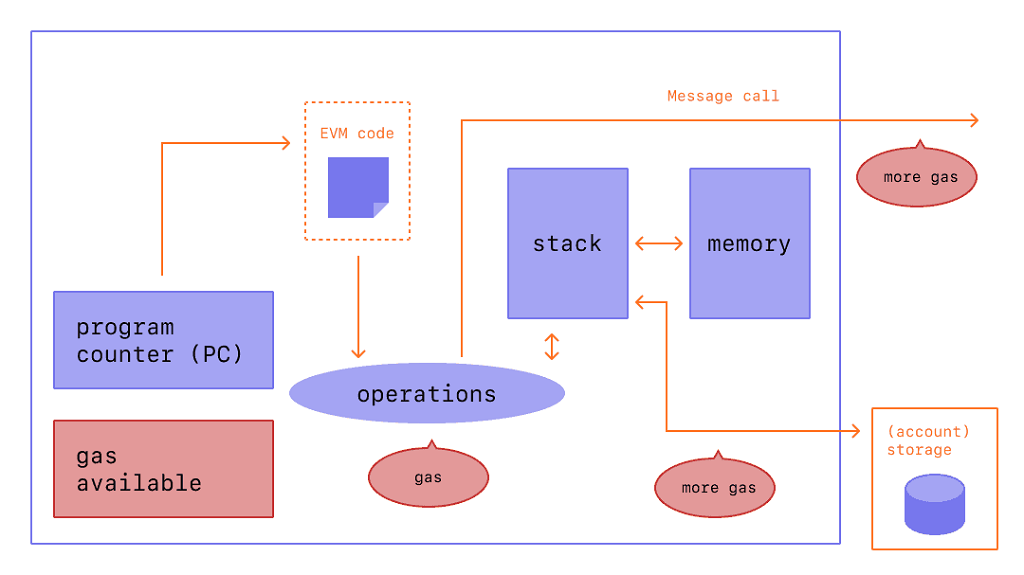Understanding How Ethereum Virtual Machine (EVM) Works: The Ethereum Virtual Machine (EVM) stands as the heart of Ethereum’s groundbreaking capabilities, driving its decentralized applications and smart contracts. It’s essential to delve into the workings of the EVM to comprehend its significance and impact on the world of blockchain technology and decentralized computing. In this article, we’ll explore the intricate mechanics of the EVM, shedding light on its architecture, execution process, and the role it plays in powering the Ethereum ecosystem.
Deciphering the Architecture of Ethereum Virtual Machine
The Ethereum Virtual Machine functions as a decentralized computer within the Ethereum network, enabling the execution of smart contracts and decentralized applications (dApps). It operates on a network of nodes, each running an instance of the EVM. Every EVM instance processes the same set of instructions and maintains the state of the Ethereum blockchain. This unified architecture ensures that all participants in the Ethereum network reach consensus on the state of transactions.
Execution Process and Role in Ethereum Ecosystem
When a user initiates a transaction or interacts with a smart contract, the EVM plays a crucial role in processing and validating these actions. Transactions are packaged with instructions in the form of bytecode – a low-level programming language. The EVM processes these instructions step by step, altering the state of the blockchain accordingly. This execution process ensures the transparency and immutability of transactions, as every participant can verify the computation performed by the EVM.
The Ethereum Virtual Machine lies at the core of Ethereum’s capabilities, facilitating the execution of smart contracts and dApps while maintaining the integrity and security of the blockchain. Understanding how the EVM operates is fundamental to comprehending the decentralized computing revolution that Ethereum has introduced. As we explore the architecture and execution process of the EVM, you’ll gain insights into its intricate mechanics and its pivotal role in the evolution of blockchain technology.
Understanding the Ethereum Virtual Machine Execution Process
The execution process of the Ethereum Virtual Machine is a fundamental aspect that ensures the accuracy and reliability of transactions and smart contracts on the Ethereum blockchain. As transactions are broadcasted to the network, the EVM processes them in a deterministic manner, ensuring that the same input will always yield the same output. This deterministic execution is crucial for maintaining consensus among all participants in the Ethereum network.
Step-by-Step Execution of Instructions
When a transaction or smart contract interaction occurs, the corresponding bytecode is fed into the EVM. The EVM then processes each bytecode instruction sequentially, updating the state of the blockchain as needed. These instructions cover a wide range of operations, from simple arithmetic calculations to more complex operations involving storage and memory manipulation. The EVM enforces a gas mechanism to manage computational resources, preventing malicious or resource-intensive code from overloading the network.
Role in Decentralized Applications and Smart Contracts
The Ethereum Virtual Machine plays a pivotal role in enabling the creation and execution of smart contracts and decentralized applications. Smart contracts are self-executing contracts with predefined rules and conditions. The EVM ensures that these contracts are executed without the need for intermediaries, thus promoting transparency and trust among parties. Decentralized applications, or dApps, rely on the EVM to perform various tasks, from token transfers to complex financial operations.
Conclusion
The Ethereum Virtual Machine is the engine that powers the Ethereum ecosystem, enabling the execution of code in a secure, transparent, and deterministic manner. Its step-by-step execution process and gas mechanism contribute to the overall stability and functionality of the Ethereum network. By understanding how the EVM works, users can gain insights into the decentralized nature of Ethereum and the potential it holds for revolutionizing various industries.
Sources:
- Ethereum.org
- Investopedia.com
- BlockGeeks.com
Hashtags: #EthereumVirtualMachine #SmartContractsExecution #DecentralizedComputing
The execution process of the Ethereum Virtual Machine is a fundamental aspect that ensures the accuracy and reliability of transactions and smart contracts on the Ethereum blockchain. As transactions are broadcasted to the network, the EVM processes them in a deterministic manner, ensuring that the same input will always yield the same output. This deterministic execution is crucial for maintaining consensus among all participants in the Ethereum network.
Step-by-Step Execution of Instructions
When a transaction or smart contract interaction occurs, the corresponding bytecode is fed into the EVM. The EVM then processes each bytecode instruction sequentially, updating the state of the blockchain as needed. These instructions cover a wide range of operations, from simple arithmetic calculations to more complex operations involving storage and memory manipulation. The EVM enforces a gas mechanism to manage computational resources, preventing malicious or resource-intensive code from overloading the network.
Role in Decentralized Applications and Smart Contracts
The Ethereum Virtual Machine plays a pivotal role in enabling the creation and execution of smart contracts and decentralized applications. Smart contracts are self-executing contracts with predefined rules and conditions. The EVM ensures that these contracts are executed without the need for intermediaries, thus promoting transparency and trust among parties. Decentralized applications, or dApps, rely on the EVM to perform various tasks, from token transfers to complex financial operations.
Conclusion
The Ethereum Virtual Machine is the engine that powers the Ethereum ecosystem, enabling the execution of code in a secure, transparent, and deterministic manner. Its step-by-step execution process and gas mechanism contribute to the overall stability and functionality of the Ethereum network. By understanding how the EVM works, users can gain insights into the decentralized nature of Ethereum and the potential it holds for revolutionizing various industries.
Sources:
- Ethereum Whitepaper
- ConsenSys Academy
- CoinDesk
Hashtags: #EVMExecutionProcess #SmartContracts #DecentralizedApplications #EVMExecutionProcess #SmartContracts #DecentralizedApplications
